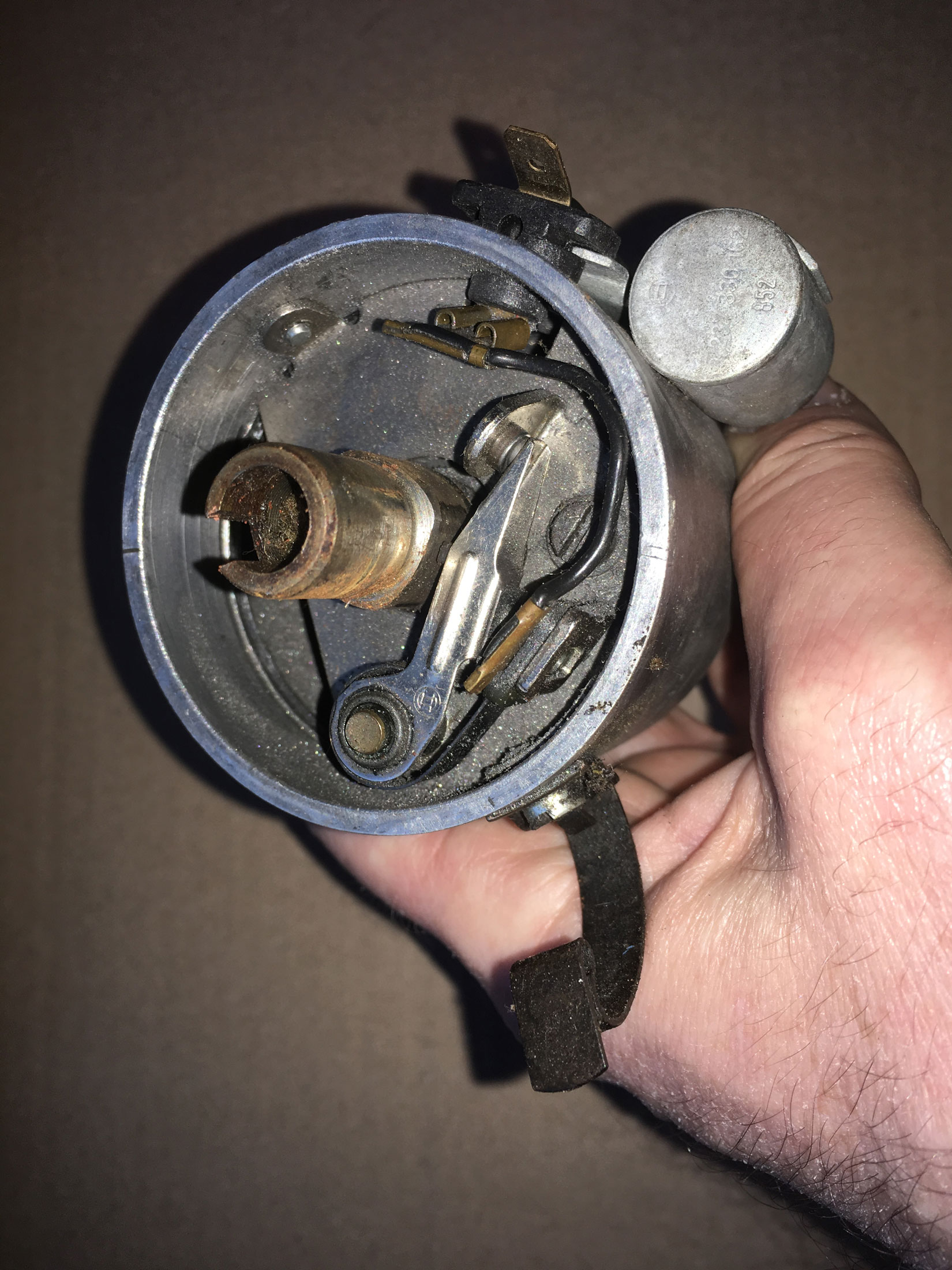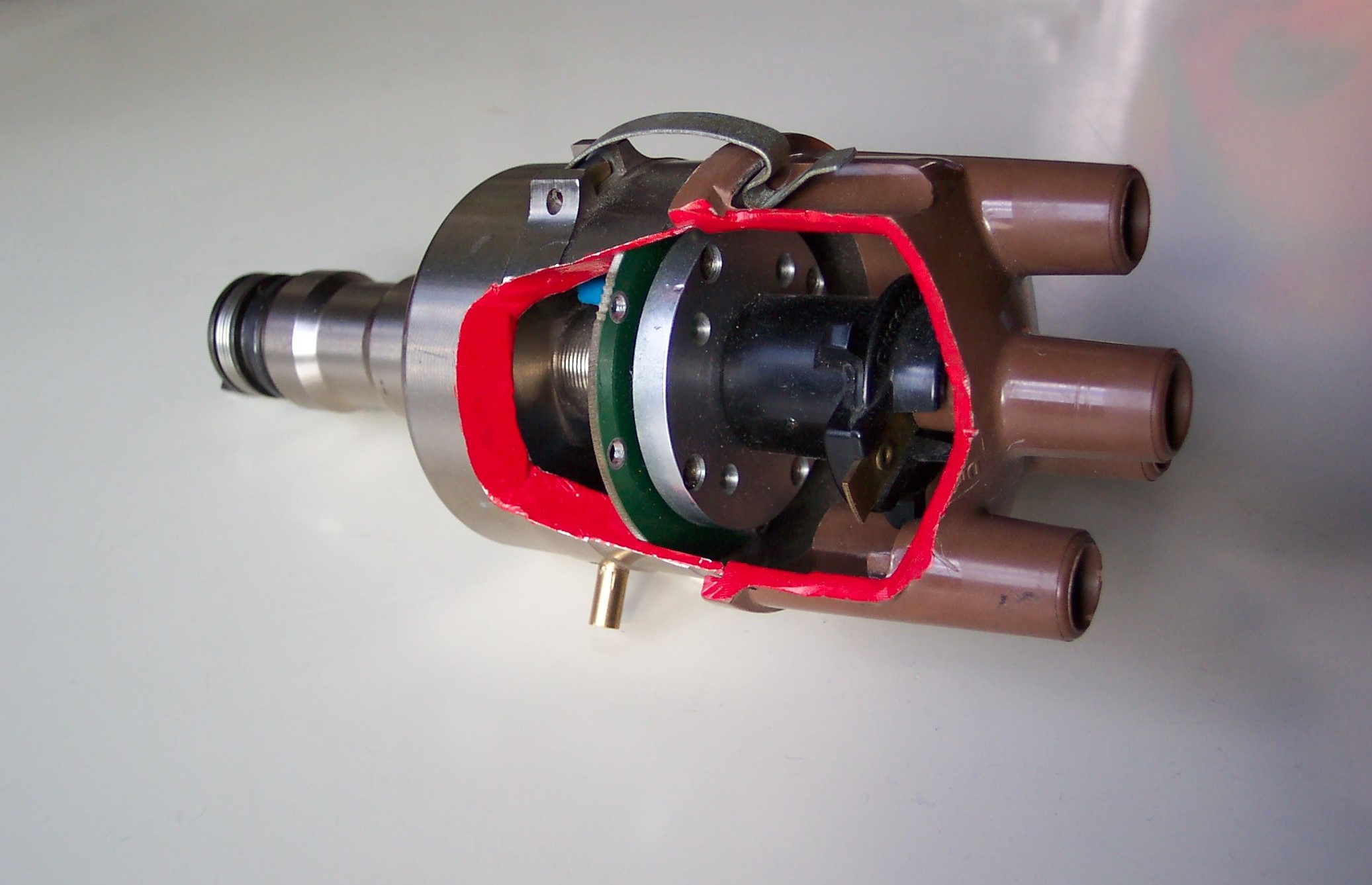Media | Articles
The great ignition debate: Points vs. Pertronix
It’s become a debate for the ages. Ford versus Chevy. Coke versus Pepsi. And now, points versus Pertronix.
For nearly 70 years, just about every car had a points-based ignition system. This venerable design was invented by Charles F. Kettering, first appeared on the 1910 Cadillac, and was used on most cars through the mid-1970s.
The basic workings are familiar to any car buff. An ignition coil contains a pair of windings around a ferrous core. A set of contact points inside the distributor are open and closed by lobes on distributor shaft as the engine spins. When the points are open, current is sent through the coil’s primary windings, creating an electric field. This sets up a magnetic field in the coil’s ferrous core. When the rotating engine causes the lobes on the distributor shaft to open the points, that current is abruptly shut off, the magnetic field collapses, and that changing magnetic field creates a second much stronger electric field. This causes high-voltage current to flow through the secondary windings, out the coil, and to the center of the distributor cap, where it is carried to the spark plug that the rotor is in contact with. In addition to all that, inside the distributor are springs and weights that conspire to advance the spark—have it fire sooner—as engine RPM increases.

It really is an ingenious and glorious electromechanical contrivance. It’s so good that it’s still with us, at least electrically—a stick coil in a modern car works by using exactly the same dual-winding principle.
Marketplace
Buy and sell classics with confidence
But the mechanical part of Kettering’s design does have a fundamental shortcoming. When the points open and close, the electric charge can cause an arc to jump between the point faces. A capacitor (the condenser) is employed to minimize the arcing, but it does not completely eliminate it. Over time, the arcing across the point faces causes them to pit and burn. This makes the point gap smaller, which in turn increases the “dwell” and decreases the amount of time that the coil has to charge up before generating the next spark. A similar problem occurs with the little nylon block that’s attached to the points and rides on the distributor’s cam lobes. Over time, the block wears down, which causes the points to not open as far.

For both of these reasons, it is the fate of all points to have their gap get smaller and smaller over time, and eventually reach the, um, point where they don’t open far enough to allow the coil to charge for long enough to generate a decent spark. Eventually they close altogether. Or the little nylon block may catastrophically snap off. When either of these things happens, your vintage car dies. If you’re lucky, it happens someplace where you can pull over, diagnose the problem, replace the points with a spare set you have in your glovebox, use a matchbook or feeler gauge to re-gap them, and be on your way, as happened to my wife and me in her ’71 VW bus in Texarkana in 1982. She thought I was a god as I shook my head and said “It’s always the bloody points.”
There’s another less catastrophic but important problem with the points closing up: It changes the ignition timing. For every degree that ignition dwell increases, the ignition timing retards by one or two degrees. Thus, the natural wearing of the point gap actually causes the timing itself to wear. If the car is just a tool-around cruiser, it’s not a huge deal, but if you’re vintage-racing the car, or even driving right-foot-down often on the street, the fact that a shrinking point gap retards the ignition timing is a reason to keep the ignition maintained.
And this raises a third problem. The tune-up of a vintage car usually includes replacement of the points and condenser. However, due to globalization, even if you buy the parts at the dealer, you really have no idea where they’re coming from and what their quality is. I tuned up one of my BMW 2002tiis using new points and a new condenser that came in BMW-logoed boxes purchased at the dealer, and the condenser went bad in five miles.
It’s for these reasons that the ignition—particularly the points—is one of “The Big Seven” reasons that a vintage car may die. Fortunately, there is something you can do about it.
When points were superseded by electronic (also called “breakerless”) ignition in the mid-1970s, a star wheel and pickup replaced the points in the distributor sent a reluctance signal to an electronic box that was mounted on the firewall. However, for decades, there have been a number of small aftermarket triggering systems that replace the points and condenser and reside completely inside the distributor. While there were optical systems where light from an LED was detected through a rotating slit, it’s the magnetic Hall Effect-based systems that have come to dominate the aftermarket. Vendors include Hot-Spark, Mallory, and brand-X products that come and go on eBay, but one of the best-known ones is from Pertronix (or PerTronix, if you want to use their case capitalization). To be absolutely clear, I have no relationship with Pertronix. I single it out only because it’s the one I’ve used myself.
The Pertronix “Ignitor” has a typical configuration of a modern Hall Effect triggering system. There are two pieces—a small triggering module that replaces the points and condenser in the distributor via a small adapter plate, and a magnetic sleeve that slides over the lobes and sits under the rotor. There’s one magnet inside the sleeve for each of the cylinders. The triggering module senses each magnet as it whizzes by, and fires the coil.

Installation is quite simple. Remove the condenser, thread the two wires through the hole it left, push the rubber grommet into place, press the magnetic sleeve down over the shaft, bolt the triggering module down where the points were, set it a fixed distance from the sleeve, connect the red wire to the power supplying the coil and the black wire to the coil’s “-” terminal, reset the ignition timing, and you’re done. It’s easiest if you remove the distributor, as working the little rubber grommet into the hole previously occupied by the plug for the condenser sometimes requires a little dexterity, but if you do it with the dizzy in place, great.
Note that a triggering module such as the Pertronix Ignitor is a substitute for the points and condenser, but nothing more. It doesn’t affect performance. It doesn’t give you a “hotter spark” (despite the fact that one vendor is literally named “Hot-Spark”) or fire the plugs multiple times in rapid succession. You would need a different product to do those things. And, after installing it, you still have an old distributor whose spark timing is advanced mechanically using springs and weights. If you have a European car, you can look at replacing your whole distributor with one from “123 Ignition.” These distributors have not only electronic triggering, but also programmable electronic spark advance (no more weights and springs). This typically does give a performance improvement. Folks rave about them. However, the cost of a 123 distributor is about $500, whereas a Pertronix or similar triggering module is typically $70 or less. If your distributor is advancing correctly and you simply want to eliminate the vagaries of points, a triggering module is all you really need.

Some folks don’t want to give up points. They want to keep them as part of the electromechanical décor of their vintage car, and I can totally respect that. A good friend of mine was that way, until he had the nylon block snap completely off a new OEM set of points on its first road trip. While he was going 80. His romance with points ended as abruptly as his forward momentum. Other folks are worried that a triggering module will affect the stock look of their engine compartment. It’s pretty subtle—just a red and a black wire from the distributor to the coil.

Regarding reliability, I can’t speak for other triggering module brands, but I’ve had the Pertronix “Ignitor” unit in six cars, and I’ve never had one fail on the road. I did, however, blow two of them up during installation. Both were entirely my fault. One was due to my simply wiring it incorrectly. It failed immediately. The other was more subtle. Most vintage cars were originally equipped with a ballast resistor in line with the coil. The resistor’s purpose is to be bypassed during starting to provide a stronger spark. Sometimes a prior owner removed the resistor in an attempt to always provide a stronger spark. The Pertronix documentation explicitly states that the total resistance of the coil plus the ballast resistor must be at least 3 ohms. If it’s less, the ignition will draw more current than the Pertronix is rated for, and fry it. I had one die that way after running for a few minutes in my garage. Lastly, Pertronix’s documentation also states that if the ignition is left on for more than a short period of time without the engine running, it can pop the unit. This is good advice for any vintage ignition system, as coils are designed to be fired, not to have always-on current.
Some people express concern that if a triggering module dies, it can’t be diagnosed, only replaced. That’s not entirely true. Buried in Pertronix’s documentation is a procedure to measure the module’s voltage with a multimeter as you move the magnetic ring toward and away from it. And yes, I still keep a set of points and a condenser in the glovebox just in case. But that’s not a lack of faith in the Pertronix; I did that when I used points too.
Lastly, Pertronix appears to be popular enough (at least in my vintage BMW world) that it gets blamed for problems with other brands. On one of the forums I regularly peruse, I find people trashing Pertronix when what failed on them was actually some unbranded module bought on eBay.
So do your own research and make up your own mind. I love not worrying that my points will choose the approach to the Tappan Zee Bridge as the place they’ll close up. And when I see someone else’s vintage car by the side of the road with the hood up, I can still shake my head and say, “It’s always the bloody points.”
***
Rob Siegel has been writing the column The Hack Mechanic™ for BMW CCA Roundel magazine for 30 years. His most recent book, Just Needs a Recharge: The Hack Mechanic™ Guide to Vintage Air Conditioning, is available on Amazon (as are his previous books). You can also order personally inscribed copies here.











In the 3rd line of the 3rd paragraph it states “when the points are open current is sent through the coil”. Should this not be when the points are closed?
Thanks,
Ivan